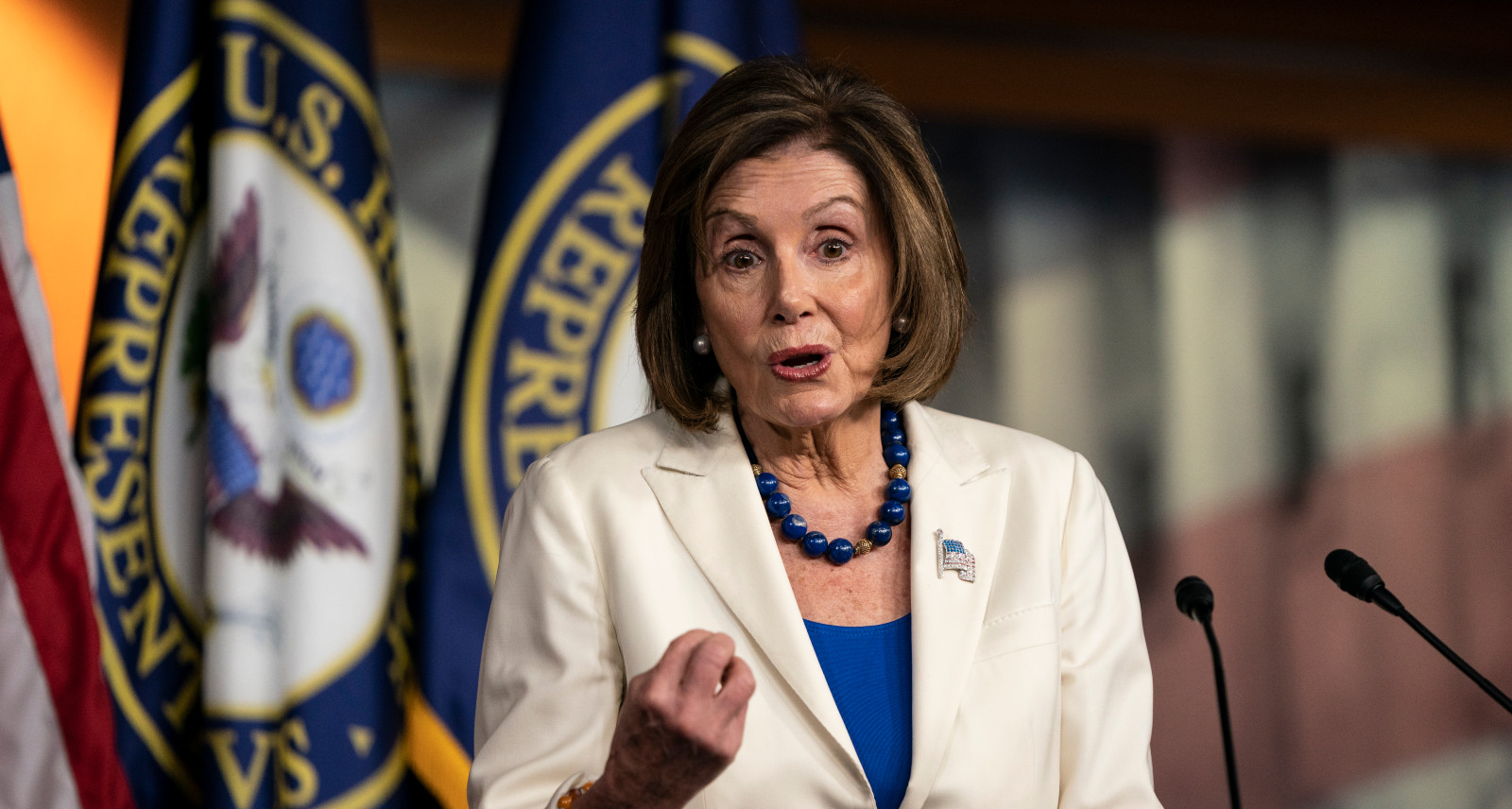In the lead-up to the 2024 presidential election, a secretive yet deeply influential conversation occurred between House Speaker Emeritus Nancy Pelosi and President Joe Biden. It is a conversation that would not only have significant political ramifications but also impact the trajectory of Biden’s campaign and his decision to drop out. The details of this exchange, revealed in the book Fight: Inside the Wildest Battle for the White House by Jonathan Allen and Amie Parnes, shed light on the internal conflicts within the Democratic Party and its strategy in the face of growing challenges, particularly with regard to the looming shadow of Donald Trump.
At the center of the story is Pelosi’s strategic advice to Biden, urging him not to engage in a public debate with Trump during the 2024 election cycle. The advice was not a mere suggestion; it was a calculated move rooted in a belief that Biden’s chances against Trump would diminish if he took the bait. Pelosi, a seasoned political figure who had navigated the complexities of Washington for decades, saw the risks of Biden participating in a public showdown with Trump, especially given Biden’s age and public speaking struggles.
As the political landscape shifted, Pelosi’s influence and her understanding of the delicate dynamics surrounding Biden’s campaign played a crucial role in shaping his decisions. According to reports from Allen and Parnes, Biden was eager to engage with Trump on stage, thinking it would be a way to reassert his political standing and perhaps dominate the debate. But Pelosi, understanding the gravity of the situation, advised Biden not to “lower himself” to Trump’s level. Her reasoning was that engaging with Trump in such a high-profile event would not only diminish Biden’s image but also provide Trump with a platform to manipulate public perception.
Pelosi’s advice was a direct response to Biden’s poor performance in previous debates, where he struggled to convey a sense of control and composure. Her fears were realized when Biden’s actual debate performance showed signs of his age and inability to maintain the clarity and sharpness necessary for such a high-stakes event. While Biden had once embraced the idea of meeting Trump in a political battle, Pelosi’s concern, shared by others within the party, was that Biden’s participation in the debate could do more harm than good, particularly when he was already facing declining poll numbers and increasing internal skepticism from Democratic lawmakers.
The second part of the political saga surrounding the 2024 Democratic presidential race revolves around former President Barack Obama’s covert efforts to influence the direction of the party following Joe Biden’s withdrawal from the race. Despite publicly endorsing Kamala Harris as Biden’s successor, Obama’s private actions revealed a level of skepticism about Harris’s ability to defeat Donald Trump and unite the fractured Democratic base.
Obama, widely regarded as one of the most influential figures in the modern Democratic Party, had long been a key ally of both Biden and Harris. However, as the political climate shifted in the lead-up to the 2024 election, Obama began to express doubts about Harris’s leadership potential. Sources close to the former president revealed that Obama did not believe Harris was the best candidate to represent the party in a general election, particularly given the looming challenge of facing Trump in a high-stakes race.
The revelation that Obama had worked behind the scenes to orchestrate a “mini-primary” or “open convention” following Biden’s exit from the race highlights the deep divides within the party. Obama’s efforts to explore alternative candidates were an attempt to find a stronger contender who could more effectively challenge Trump’s re-election bid. However, despite these efforts, Harris’s ascendancy to the role of the presumptive nominee remained inevitable, and Obama eventually gave his public endorsement to her. This endorsement, while crucial for party unity, came only after a tense period of private negotiations and public reluctance from Obama.
Obama’s Reluctance to Back Harris
While the Democratic establishment had positioned Harris as Biden’s natural successor due to her position as vice president and her appeal to key demographic groups, Obama’s initial reluctance to support her underscored a lack of confidence in her ability to win the 2024 election. His behind-the-scenes efforts to explore other options demonstrated the concerns many Democratic insiders had about Harris’s leadership, particularly in light of her mixed performance in the polls and her struggles to connect with key voter groups.
Sources revealed that Obama’s skepticism was not merely based on Harris’s political experience but also on her inability to garner widespread enthusiasm among the Democratic base. While Harris had enjoyed the backing of many within the party, her campaign was plagued by questions about her ability to inspire and energize voters. Obama’s reluctance to endorse her publicly only added to the sense of uncertainty within the party, leading to a growing divide between the party’s leadership and its grassroots supporters.
Obama’s maneuvering was also indicative of the broader power struggles within the Democratic Party. As the party’s most prominent figure, Obama wielded significant influence, and his behind-the-scenes actions to find an alternative to Harris demonstrated the extent to which he sought to shape the direction of the 2024 race. While Harris’s supporters within the party continued to rally behind her, Obama’s efforts to position other candidates as viable alternatives raised serious questions about the strength of her candidacy.
The Role of Biden and Pelosi in the Decision
Joe Biden’s eventual withdrawal from the 2024 race was a direct result of the pressure he faced within the Democratic Party. While Pelosi’s advice to Biden not to debate Trump in the wake of his poor performance during the first debate was one factor in Biden’s decision, the broader sense of doubt within the party also played a crucial role. Pelosi’s concerns about Biden’s ability to take on Trump in a public debate were rooted in her understanding of the political stakes and her long experience in the House of Representatives. Her advice was aimed at protecting Biden’s reputation and avoiding a situation in which Trump could dominate the conversation.
As Biden’s poll numbers continued to decline and his political future became increasingly uncertain, Pelosi’s influence within the party became more apparent. The Democratic Party was facing an uphill battle in the lead-up to the 2024 election, and many within the party saw Biden’s withdrawal as a necessary step toward finding a candidate who could better unite the party and challenge Trump. Pelosi’s guidance to Biden to step aside was not only about ensuring his political survival but also about positioning the party for success in the coming election.
Biden’s withdrawal marked a turning point for the Democratic Party. With Harris emerging as the frontrunner, the focus shifted to how the party would unify behind her and how she would navigate the challenges of running against a formidable opponent like Trump. Harris, who had already been subjected to scrutiny during the early days of the 2020 election cycle, now faced an even steeper climb to prove her viability as the Democratic nominee.
The Impact of Obama’s Endorsement of Harris
Despite Obama’s initial reluctance, his eventual endorsement of Kamala Harris was a critical moment in the 2024 election cycle. His endorsement not only solidified Harris’s position as the Democratic nominee but also sent a clear message to the party that it needed to rally behind her. Obama’s backing was seen as a necessary step in unifying the party, particularly given the growing division among Democratic voters over Harris’s candidacy.
However, Obama’s endorsement was not without its complications. While many within the Democratic establishment embraced Harris as Biden’s successor, there remained significant skepticism among certain factions of the party. Obama’s endorsement did little to dispel the doubts of those who felt that Harris was not the right candidate to take on Trump. This internal division within the party would play a significant role in the coming months as the Democratic race intensified and Harris faced increasing pressure to prove her ability to connect with voters.
As the 2024 election continued to unfold, it became clear that Harris’s path to the presidency would not be easy. Despite her position as the presumptive nominee, Harris faced mounting criticism from both within her own party and from the opposition. The pressure on Harris to deliver a successful campaign became even greater as the general election approached, and the stakes for the Democratic Party grew higher.
Obama’s Influence in the 2024 Election
Obama’s role in the 2024 election cycle cannot be understated. His influence within the Democratic Party remained strong, and his behind-the-scenes actions shaped the course of the race in ways that were not immediately apparent to the public. While his endorsement of Harris was a pivotal moment, Obama’s reluctance to back her initially revealed the underlying concerns about her candidacy. These concerns would continue to reverberate throughout the election cycle as Harris faced mounting pressure to prove herself as a viable candidate.
Obama’s influence was not limited to his endorsement of Harris; he also played a key role in shaping the party’s overall strategy for the election. As the party’s most prominent figure, Obama’s involvement in the 2024 race sent a clear message that the Democratic Party was committed to defeating Trump and ensuring that the party’s vision for the future was realized. His guidance and support were seen as essential for Harris’s success, but the internal divisions within the party made it clear that the path to victory would not be easy.
Conclusion: The Road Ahead for Kamala Harris
The events leading up to the 2024 election, as detailed in Fight: Inside the Wildest Battle for the White House, reveal the deep divisions within the Democratic Party and the significant challenges Kamala Harris faced as she sought to unite the party and defeat Donald Trump. The internal struggles, combined with Obama’s reluctance to support Harris, created a tense and uncertain atmosphere within the party. However, despite these challenges, Harris ultimately emerged as the Democratic nominee, and her ability to navigate the complexities of the race would determine the future of the party.
As the election drew closer, the focus shifted to how Harris would engage with voters, address the concerns of the party’s base, and present herself as the candidate best suited to take on Trump. Despite the obstacles in her way, Harris’s campaign would continue to evolve as she worked to gain the trust and support of the American people. The Democratic Party’s future hung in the balance, and the 2024 election would prove to be a pivotal moment in American politics.
In the end, Harris’s journey to the presidency was a reflection of the internal struggles, political maneuvering, and complex dynamics that shaped the Democratic Party’s response to the challenges of the Trump era. As the election unfolded, it became clear that Harris’s ability to unite the party and connect with voters would be critical to her success in the race against Trump.
WATCH:

